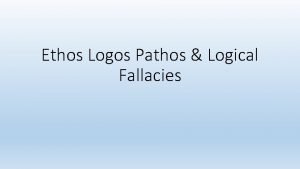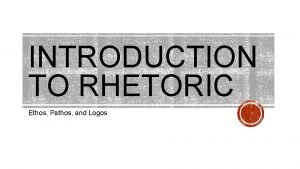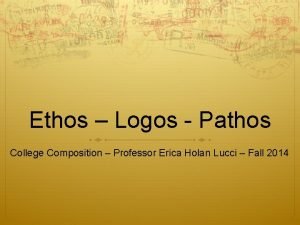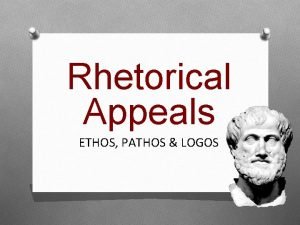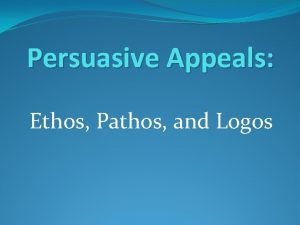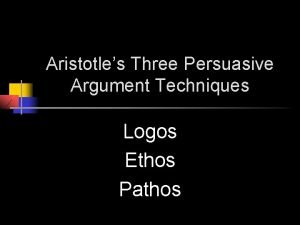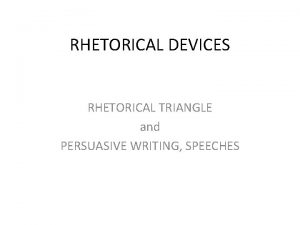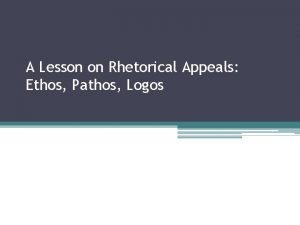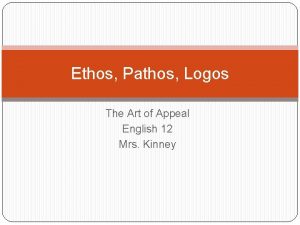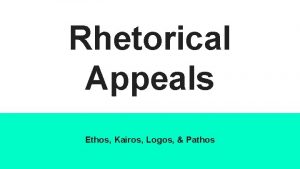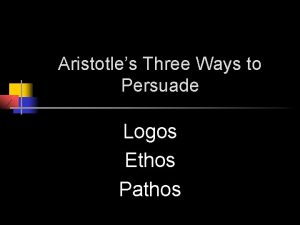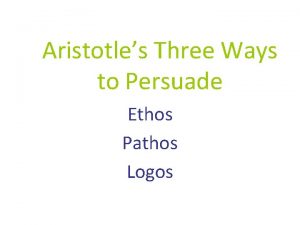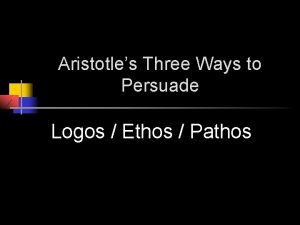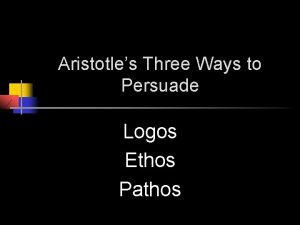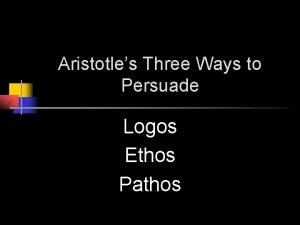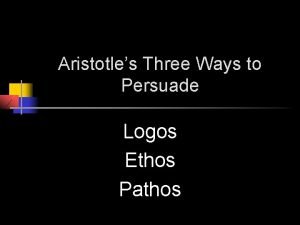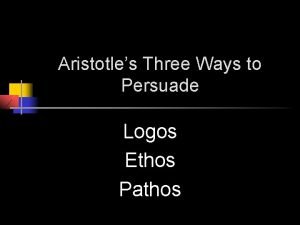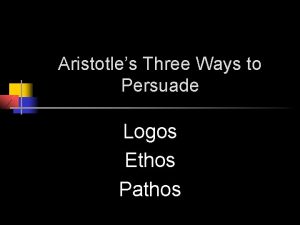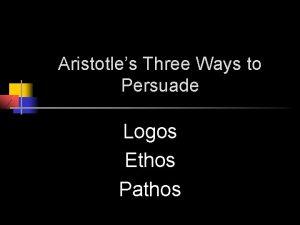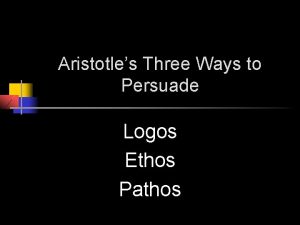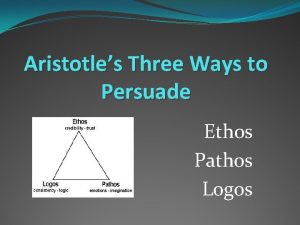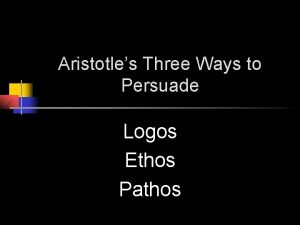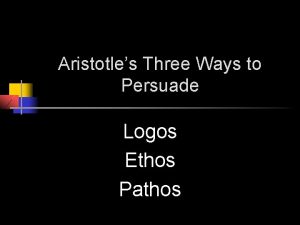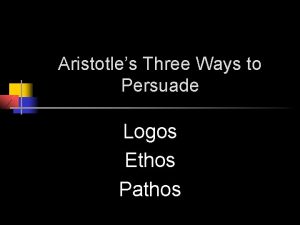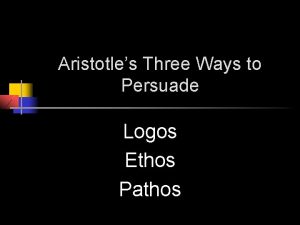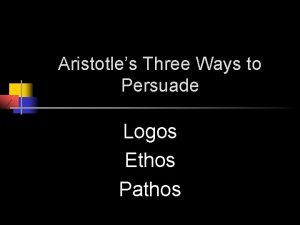Logos Ethos Pathos Aristotles Three Ways to Persuade


















- Slides: 18

Logos Ethos Pathos Aristotle’s Three Ways to Persuade

Who is Aristotle? Aristotle (384 -322 BCE) is the most notable product of the educational program devised by Plato. Aristotle wrote on an amazing range of subjects, from logic, philosophy, and ethics to physics, biology, psychology, politics, and rhetoric.

What is rhetoric? Rhetoric is the art of persuasion. The goal of persuasion is to change others’ point of view or to move others to take action.

What is logos, ethos, and pathos? Logos = Logic Ethos = Ethics, Morals, reputation Pathos = Emotions (Passion)

Logos, Ethos, Pathos Using logos, ethos, and pathos will help you to master the art of persuasion. • Through language, you will be able to change the point of view of others! • Through language, you will be able to motivate others to take action!

Logos is an argument based on facts, evidence and reason. Using logos means appealing to the readers’ sense of what is logical.

Ethos is an argument based on morals. Using ethos means the writer or speaker appeals to the audience’s sense of ethical behavior. The writer or speaker presents him or herself to the audience as credible, trustworthy, honest and ethical. “I am an ethical expert, so believe what I say. ”

Pathos = argument based on feelings Using pathos means appealing to readers’ emotions and feelings.

Logos = Head Ethos = Hand Pathos = Heart Symbols for Logos, Ethos and Pathos found in literature

Ethos

Ethos What does this company want you to think about their water?

Logos Example The University of Chicago just got the 10 single-use restrooms on campus designated gender neutral. It’s time Yale followed suit. And this is not just an academic problem. There are tens of thousands of single-use toilets at workplaces and public spaces throughout the nation that are wrongheadedly designated for a single-sex. All these single-use toilets should stop discriminating. They should be open to all on a first-come, first-lock basis. —Ian Ayres, “Looking Out for No. 2”

Ethos Example Would you eat a steak dinner beside a starving, homeless man? To do something like this would be completely wrong and unethical. Our morals forbid this kind of cruelty. So why then, do we spend all of our money on lavish foods when our neighbors in Greensboro are going without meals?

Pathos Example In the following example from a speech by Winston Churchill, note the use of anaphora This repetition emphasizes the point and expresses passion and emotion. Moreover, the repetition affects the audience emotionally.

Pathos Example We shall not flag or fail. We shall go on to the end. We shall fight in France, we shall fight on the seas and oceans, we shall fight with growing confidence and growing strength in the air, we shall defend our island, whatever the cost may be, we shall fight on the beaches, we shall fight on the landing grounds, we shall fight in the fields and in the streets, we shall fight in the hills. We shall never surrender. —Winston Churchill, speech to the House of Commons, June 4, 1940

Review Logos = logic Logos is an argument based on facts, evidence and reason. Using logos means appealing to the readers’ sense of what is logical.

Review Ethos = Ethics / Image Ethos is an argument based on character. The writer or speaker presents him or herself to the reader as credible, trustworthy, honest and ethical.

Review Pathos = argument based on feelings Using pathos means appealing to readers’ emotions and feelings.
 Ethos logos pathos quiz
Ethos logos pathos quiz Ethos, pathos, logos greek
Ethos, pathos, logos greek Logos rhetoric definition
Logos rhetoric definition Logos ethos pathos
Logos ethos pathos Kahoot rhetorical devices
Kahoot rhetorical devices Logos advertisement
Logos advertisement Rhetorical triangle logos
Rhetorical triangle logos Ethos, pathos, logos
Ethos, pathos, logos Three persuasive techniques
Three persuasive techniques Logos definition literature
Logos definition literature Appeal to pathos
Appeal to pathos Ethos patos logos
Ethos patos logos Whats an argumentative essay
Whats an argumentative essay Advertisements ethos pathos logos
Advertisements ethos pathos logos Appeal to character
Appeal to character Kahoot social credit test
Kahoot social credit test Ethos pathos logos quiz
Ethos pathos logos quiz What are kairos
What are kairos Pathos ethos logos
Pathos ethos logos
